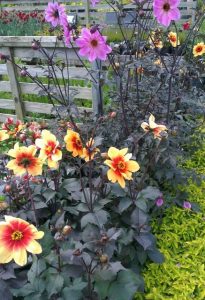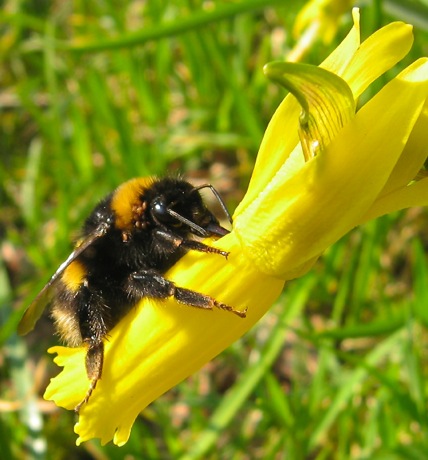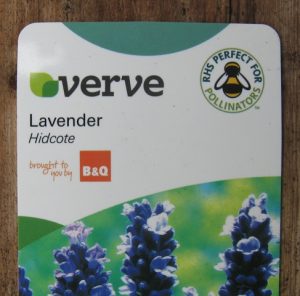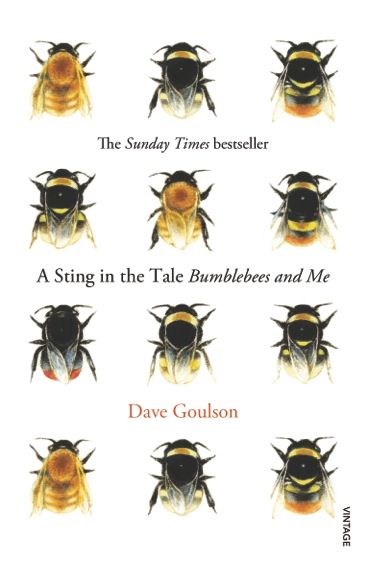Could plants tagged ‘perfect for pollinators’ actually be poisoning them? A new crowdfunded project is aiming to find out.
Dave Goulson, Professor of Biology at Sussex University, is a scientist on a mission. After a childhood spent chasing butterflies and collecting birds’ eggs, he went on to study biology, did a PhD in butterfly ecology, then specialised in bumblebee ecology and conservation. In 2006 he became Professor of Biology at Stirling University, founding the Bumblebee Conservation Trust the same year. He is author of the best-selling A Sting in the Tale and A Buzz in the Meadow, and co-founder of the UK citizen science charity The Buzz Club, which helps us learn more about our insect neighbours.

Over the last five years, Dave Goulson has been studying the effects of pesticides on our wild bees, with a particular focus on pesticides called neonicotinoids (or ‘neonics’), which harm bees and other pollinating insects. They are widely used in agriculture and horticulture, and are sold by most gardening retailers. The latest and possibly most vital leg of his mission to protect bees is a crowdfunded, people-powered project investigating just how widespread the use of these pesticides is in the plants – including ones labelled ‘perfect for pollinators’ – that gardeners buy. So far the crowdfunding has reached £6,000 – double its original goal. The more the project raises, the more research Dave Goulson and his team can carry out (pledges start from £3).
I donned my earth-friendly gardener’s hat to ask Dave Goulson my own burning questions about neonicotinoids, the pesticide industry spin, his hopes for his current project, and the outlook for bees following Brexit.
Can you sum up what neonicotinoids are, how they work, and why gardeners should be concerned about them being used on the plants they buy?
Neonics are neurotoxins, synthetic relatives of nicotine. They attack the brain of the insect, causing paralysis and death, and at lower doses interfere with navigation, disease resistance and learning. They are remarkably toxic to insects; just four-billionths of a gram is a lethal dose to a honeybee, meaning one teaspoon of neonics is enough to give a lethal dose to one and a quarter billion bees. Neonics work ‘systemically’ in plants and can be sprayed onto leaves, watered into the soil, or used as a seed coating. Whatever route is used, they end up throughout the tissues of a plant, including in its sap, nectar and pollen. They are also highly persistent; once in the soil they remain there for years.
When I buy a plant at a garden centre or a supermarket, is there any way to tell if it has been treated with neonics, either by looking at the plant or from the label?
None whatsoever, and labels give no indication. As far as I know, plants labelled ‘bee-friendly’ are just as likely to have been treated as other flowers.

Which are more likely to contain bee-harming levels of neonics: seeds, bulbs/corms/tubers, young ‘plug’ plants, or larger plants growing in pots?
We don’t know, but hope to find out. Seeds are probably safe, as those sold for home use are not, to my knowledge, treated with neonics. Growing from seed or, better still, doing plant swaps with your neighbours are the best ways to ensure healthy, pesticide-free plants.
I might decide to grow my own plants from seed to be sure they’re not polluted by neonics, but my neighbours might be routinely using these chemicals, or buying plants which could be contaminated. Do bees have any way of detecting neonic-tainted flowers, visiting only the ‘clean’ ones?
No, bees cannot tell if a plant contains neonics. There is even some evidence from a laboratory study suggesting they prefer to drink poisoned nectar over healthy nectar, but this remains controversial and requires more study.
If a bumblebee forages along a row of adjacent gardens, such as those behind a terrace, could it pick up enough neonics to cause it serious harm?
Concentrations of neonics found in the pollen and nectar of treated agricultural crops, such as oilseed rape, are certainly enough to do harm, so it seems common sense that the amounts in treated ornamental flowers may also harm bees, although this has not been tested.
What would happen to a bee poisoned by these pesticides – would it drop out of the air mid-flight, or crawl away quietly and die?
Poisoning would be slow and chronic and its behaviour would be affected: it might forage less, or get lost on the way back to the nest. Overall, exposed bumblebee colonies would grow more slowly and produce fewer new queens, but there would be no dramatic pile of dead bodies.
How far up the garden ‘food chain’ can neonics travel? If someone sprays their plants (e.g. roses) to kill aphids, and those poisoned aphids are then eaten by garden wildlife such as blue tits or common wasps, will they receive a dose of the pesticide as well?
We don’t know, since no one has looked. One US study showed that neonic-treated soya bean seedlings were eaten by slugs, which are unaffected by neonics, but they became toxic to predatory ground beetles, which died. This resulted in much more slug damage to the crop compared with when seeds were left untreated.

Recently an organic gardener asked me what pesticides might be present in spring-flowering bulbs planted to help early foraging bees. Should they be concerned about neonics that might be present in the bulbs, which could move into the pollen and nectar, and should they dig them up?
The residues of neonics in plant tissues will certainly dissipate over time, though this has never been studied in detail – or at all in bulbs. Their half-life in soil varies widely, typically from around 100 to 300 days, which means that even at the higher end, half of them are gone within a year. I suggest they don’t remove existing bulbs, especially any that have been growing for several years, as probably the food they provide is more valuable to bees, cancelling out any harm caused by lingering trace residues.
What happens when a plant treated with neonics rots down in my compost bin?
We don’t know, but I would guess that your compost is likely to end up with some neonics in it.
What are the effects of neonics on soil life, such as earthworms?
The few studies carried out have given inconsistent results; one found severe harm to compost worms, another found little effect.
How will you analyse plants for the presence of neonics? Will you also test for other horticultural pesticides?
We will analyse the leaves and also, for plants that produce enough, we will analyse the nectar and pollen separately for neonics, and yes, we will be looking for other pesticides.
How will you use the results of this people-funded research to bring pressure on the horticulture industry to stop using bee-harming chemicals?
If we find neonics, or other harmful pesticides, this will hopefully raise the profile of the issue, leading to wider media interest which will place pressure on the trade to clean up its act. Garden retailers have capitalised on the market for ‘bee-friendly’ products, so it will be embarrassing for them if we discover they are not so bee-friendly after all.
Which chemical ‘active ingredients’ should gardeners look out for in the small print on pesticide containers?
The neonics are imidacloprid, thiacloprid, acetamiprid, clothianidin and thiamethoxam. The first of these is also used in spot-on flea treatments for dogs and cats. (A full list of neonics sold by garden retailers can be found here.)
Imidacloprid, clothianidin and thiamethoxam have been removed from UK garden retailers under an EU-wide ban, but can they still be used by commercial growers on plants sold to gardeners?
All five neonics can be used on ornamental plants, including those grown in polytunnels, but not, as I understand it, in the year of flowering. However, a soil/compost drench applied the year before is likely to be in the plant and soil/compost for a long time, possibly several years.

Given that it could appear on the labels of plants which might actually be toxic to bees, is the Royal Horticultural Society’s familiar ‘perfect for pollinators’ logo currently fit for purpose? How much responsibility do you think retailers have for ensuring their plants really are ‘fit for bees’?
Personally, I think the RHS should insist that plants be neonic-free if they are to carry the logo; I’m talking to the RHS, who are concerned about neonics, and there may be possible ways forward. To my mind it is entirely the responsibility of the retailers to ensure that their products are fit for purpose.
What’s your response to phrases such as ‘has a good profile for bees’, which is frequently used by the pesticide industry (and has spread to some parts of the gardening media) to play down the harmful effects of their products? Are there really any neonics which can be described as ‘good’ for bees?
This is nonsense. All insecticides kill insects – none have been invented that are harmless to bees, though some are more harmful than others. Thiacloprid and acetamiprid are much less toxic to bees than the other neonics, so it’s often claimed that they are ‘safe’ for bees. However, this ignores the fact that they tend to be applied at much higher doses. If you want to look after garden wildlife, don’t use any insecticides – there is absolutely no need.

Lobbyists are already trumpeting the possibility of less regulation of pesticides now we’ve voted to leave the European Union. What’s your assessment of the outlook for bees of all kinds following Brexit, and how can gardeners help mitigate any negative consequences?
A lot of legislation to protect the environment came from the EU. The neonicotinoids moratorium is one example, which our own government fought against. I don’t think our current government cares two hoots for the environment. This makes it more important than ever that we look after garden wildlife, providing a safe haven away from toxic agricultural fields.
If the horticulture industry continues to ignore the evidence and goes on using neonics on ‘pollinator’ plants, can gardeners themselves force plant suppliers to change their ways?
If growers take this tack, then naming and shaming outlets selling neonic-contaminated plants seems a good option, although I’d rather talk to them first. Gardeners do have influence – without them there would be no horticulture industry – but this only works if enough gardeners actually care about these issues.
If you could go out today and sow/plant just six different plants to benefit bees, which would they be?
Anise hyssop Agastache foeniculum, comfrey, lavender, marjoram, Phacelia tanacetifolia and viper’s bugloss Echium vulgare – but there are many more!
To find out more and contribute to Professor Dave Goulson’s people-powered research into bee-harming pesticides found in garden plants, visit his crowdfunding page.
Text and images © John Walker. Book jacket courtesy Vintage Books.
Find John on Twitter @earthFgardener










